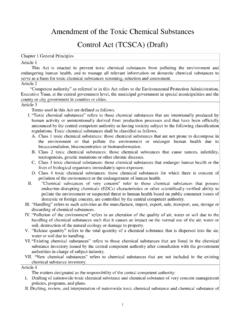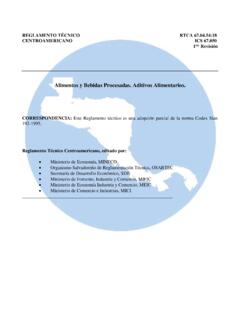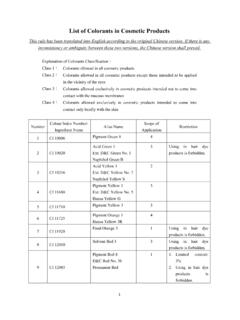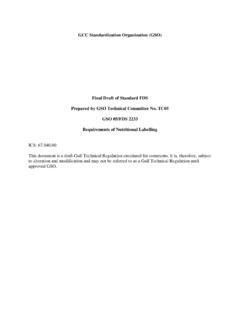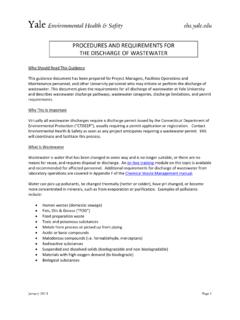Transcription of Basic requirements for a slaughter house - Specification
1 DRAFT KENYA STANDARD. ICS . Basic requirements for a slaughter house - Specification No copying of this standard without KEBS permission except as permitted by copyright law PUBLIC REVIEW DRAFT, JANUARY 2018. KEBS 2017 First Edition 2017. KEBS. KENYA STANDARD. Basic requirements for a slaughter house - Specification No copying of this standard without KEBS permission except as permitted by copyright law PUBLIC REVIEW DRAFT, JANUARY 2018. KEBS 2017 First Edition 2017. 2 KEBS 2017 All rights reserved KEBS. TECHNICAL COMMITTEE REPRESENTATION. The following organizations were represented on the Technical Committee: Ministry of Agriculture. Livestock and Fisheries- Directorate of Livestock Production Ministry of Agriculture. Livestock and Fisheries - Directorate of Veterinary Services Kenya Camel Association (KCA). University of Nairobi (UON). Kenya Industrial Research and Development Institute (KIRDI). Kenya Agricultural and Livestock Research Organization (KARLO).
2 International Livestock Research Institute (ILRI). Farmers Choice (K) Ltd Consumer Information Network Ministry of Health- Food Safety Unit National Public Health Laboratory Government Chemist's Department Kenchic (K) Ltd. Kenya Meat Commission Kenya Nut Company Limited Morendat Farm Choice Meats Limited Quality Meat Packers Limited Kenya Bureau of Standards (KEBS)- Secretariat REVISION OF KENYA STANDARDS. In order to keep abreast of progress in industry, Kenya standards shall be regularly reviewed. Suggestions for improvement to published standards, addressed to the Managing Director, Kenya Bureau of Standards, are welcome. Kenya Bureau of Standards, 2017. Copyright. Users are reminded that by virtue of Section 25 of the Copyright Act, Cap. 12 of 2001 of the Laws of Kenya, copyright subsists in all Kenya Standards and except as provided under Section 26 of this Act, no Kenya Standard produced by Kenya Bureau of Standards may be reproduced, stored in a retrieval system in any form or transmitted by any means without prior permission in writing from the Managing Director.
3 ISBN 9966-19-638-2. KEBS 2017 All rights reserved 3. KEBS. KENYA STANDARD. Basic requirements for a slaughter house - Specification KENYA BUREAU OF STANDARDS (KEBS). Head Office: Box 54974, Nairobi-00200, Tel.: (+254 020) 605490, 602350, Fax: (+254 020) 604031. E-Mail: Web: Coast Region Lake Region Rift Valley Region Box 99376, Mombasa-80100 Box 2949, Kisumu-40100 Box 2138, Nakuru-20100. Tel.: (+254 041) 229563, 230939/40 Tel.: (+254 057) 23549, 22396 Tel.: (+254 051) 210553, 210555. Fax: (+254 041) 229448 Fax: (+254 057) 21814. 4 KEBS 2017 All rights reserved KEBS. Foreword This Kenya Standard was prepared by the Meat and Meat Products Technical Committee under the guidance of the Standards Projects Committee, and it is in accordance with the procedures of the Kenya Bureau of Standards. During the preparation of this standard, reference was made to the following documents: Codex standard for processed meat and poultry products part 1 Volume 10 1994.
4 Kenya Meat Commission Act Cap 363. Meat Control Act Cap 356. Legal notice number 110 of 2010 - meat control act Red Meat Manual- Republic of South Africa Food, drugs and chemical substances Act Cap 254. EMCA Act Cap 387. Public health Act Cap 242. Indian Standard- Basic requirements for an Abattoir (First Revision). Guideline Manual for the Management of Abattoir and other wastes of animal origin- Department of Agriculture and Rural Development, Gauteng Provincial Government- South Africa The assistance derived from the above sources is highly acknowledged. KEBS 2017 All rights reserved 5. KEBS. 1. SCOPE. This Kenya Standard specifies Basic requirements for a slaughter house for carrying out slaughter of a food animal. 2 Normative references The following referenced documents are indispensable for the application of this document. For dated references, only the edition cited applies. For undated references, the latest edition of the referenced document (including any amendments) applies I.
5 KS EAS 39 - Hygiene in the food and drink manufacturing industry - Code of practice. II. KS ISO 22000 Food Safety Management Systems - requirements for any organization in the food chain. III. KS EAS 151 - Hazard Analysis Critical Control Points (HACCP). IV. KS 2299 Code Of Practice for Ante-mortem and post-mortem inspection of meat animals. V. KS CAC/RCP 58-2005, Codex code of hygienic practice for meat. VI. KS EAS 12 - Specification for potable water 3 DEFINITIONS. For the purpose of this standard the following definitions shall apply: Food Animal- any mammal or bird declared to be an animal for slaughter . Carcass- the body of any slaughtered animal after bleeding and dressing. Evisceration . to disembowel and remove entrails of a carcass Lairage- means holding pens for livestock at a slaughterhouse prior to slaughtering. Meat- means any portion of an animal which is intended for human consumption, whether fresh, chilled or frozen or otherwise processed by any means whatsoever or included in any article of food for human consumption.
6 Red offal . include heart, liver, kidney, spleen, tongue, lungs, pancrease. Green offal . include the rumen, reticulum, omasum, abomasum, small intestines, large intestines, colon, and gizzards. White offal- include the brain, spine, bone marrow, testicles and teats. Slaughterhouse- means any place kept for the purpose of the slaughter of animals for human consumption. Stunning- is any mechanical, electrical, chemical or other procedure which causes immediate loss of consciousness;. when used before slaughter , the loss of consciousness lasts until death from the slaughter process; in the absence of slaughter , the procedure would allow the animal to recover consciousness. fractious animals- animal that would not submit to the harness. readily angered; peevish; irritable; quarrelsome clean area . area designated for slaughter operations after evisceration to dispatch 6 KEBS 2017 All rights reserved KEBS.
7 Unclean/dirty area . area designated for slaughter operations from stunning to evisceration Unclean operation . In animal slaughter , unclean(dirty)operations entail animal handling in lairages, stunning, bleeding, flaying or scalding (in pigs or poultry),remove of trotters, head, hide or skin/hair or feathers (in pigs or poultry). Clean operations - evisceration, carcass splitting; diaphragm, fat, tail trim; carcass washing and dispatch to the cold room. 4. LOCATION. A slaughterhouse shall be located in an area which is reasonably free from objectionable odors, smoke and dust. Adequate dust-proof access-ways connecting the slaughterhouse with public roads shall be available. The slaughterhouse must be completely separated from any other buildings used for industrial, commercial, agricultural, residential or other purposes other than connected building used for the processing of the meat The plan for construction of slaughter house shall follow the relevant provisions of EMCA Act, Physical Planning Act, Meat Control Act, Food Drugs and Public Health Act, Public Health Act and County physical Development Plans.
8 The slaughter house site shall be guided by the Part Development Plan (PDP) of the area. General Provision. slaughter house shall be hygienically managed and under the supervision of a competent authority. A slaughterhouse shall have . (a) Properly built and drained lairage erected not less than ten meters from the slaughterhouse and equipped with adequate facilities for ante-mortem inspection and Isolation pens for suspect animals. (b) Fenced cattle races from the lairages to the slaughterhouse, properly drained and in a suitable place equipped with facilities for washing the animals. (c) Separate facility for handling hides and skins (d) Separate room for the cleaning and treatment of intestines and ovals. (e) Separate room for the storage, disposal and treatment of inedible and condemned animals, carcass and meat. (f) Impervious, easily cleaned and resistant to wear and corrosion materials. (g) Floors constructed of dense, acid-resistant, waterproof concrete and have appropriate non slip finish.
9 (h) Walls smooth and flat and made of smooth-surfaced Portland cement plaster or other non-toxic, non-absorbent material applied to a suitable base, and walls shall be provided with sanitary bumpers to prevent damage by movable equipment. (i) Coves with sufficient radii to promote good sanitation shall be installed at the juncture of floors and walls in all rooms. (j) Ceilings of adequate head room be smooth and flat and be constructed of portland cement plaster or other acceptable impervious material that allow for easy cleaning (k) Provisions for adequate natural lighting and ventilation (l) Doorways at least one hundred and fifty centimeters wide and the doors must be made of rust- resistant metal having tight soldered or welded seams. Door jambs shall be covered with rust- resistant metal. (m) Pest proofing to prevent the entry of insects and rodents (n) Dressed timber used for all exposed interior wood work, and it shall be painted with a good non- toxic oil or plastic base paint, treated with linseed oil or with a clean wood sealer.
10 (o) all parts of floors where wet operations are conducted well drained, with at least one drainage inlet provided for each thirty five square meters of floor space. The inlets shall be placed under the KEBS 2017 All rights reserved 7. KEBS. dressing rails if necessary together with drainage valleys, not less than seven decimal five centimeters wide, with a slope of the floor towards drainage valleys or inlets of at least two decimal five centimeters per meter. (p) Drains for paunch and stomach contents at least twenty centimeters in diameter. (q) Waste disposal system of adequate size and must comply with Environmental Management and Coordination Act (EMCA1999) and local regulations. 5 slaughter house LAYOUT PLAN. The slaughter house shall have the essential facilities for the following activities: I. Receiving the animal II. ante-mortem inspection III. isolation of sick/diseased animals IV. Resting place for animals before slaughter V.

